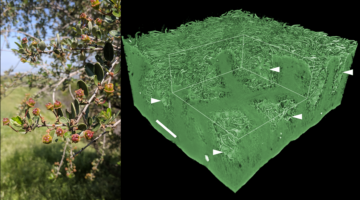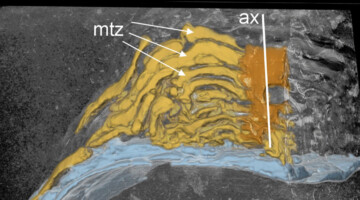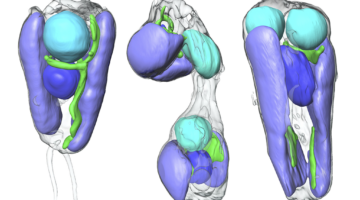Many species of California lilac grow throughout the state, north to Humboldt and south to San Diego. Some species have developed an adaptation for arid climates: the stomatal crypt. This extremely rare anatomy intrigued a group of researchers, who characterized species with these crypts at the ALS. Their microtomography characterization revealed how the stomatal crypt helps plants survive drought. Read more »
ALS Work Using Tomography
Tomography allows 3D imaging of structures inside samples without the need to physically slice them open. A series of images is collected as a sample is rotated, and the raw data is computationally converted into digital sections that can be stacked to reconstruct 3D visualizations of the sample. The very high flux of x-rays and infrared light at the ALS allows collection of high-quality, high-speed 3D images at nanometer or micrometer resolution. Synchrotron tomography also enables photon-energy tuning for element- and chemistry-specific contrast, as well as phase-contrast imaging.
Native American Interns Explore Engineering Opportunities at the Lab
This last summer, Berkeley Lab hosted three students from Navajo Technical University in a DOE-funded initiative that partners national labs with learning institutions whose populations are historically underrepresented in science. The goal is to increase enrollment of Native American students in Navajo Tech engineering programs. Read more »
The Spatial Dynamics of Bone Remodeling During Lactation
To mobilize the minerals needed for milk production, osteocytes—the cells responsible for maintaining bone quality—facilitate the release of calcium and other minerals from the bone matrix surrounding them. In this study, researchers investigated how osteocytes balance the rapid release of calcium with maintaining bone integrity. Read more »![]()
Pacific Kelp Forests Are Far Older than We Thought
Researchers scanned newly discovered kelp fossils using x-ray tomography at the ALS. The images provided morphological information about the ancient kelp and, along with isotopic analyses, provided insights into the evolutionary history of northeastern Pacific Ocean kelp forests, which flourished more than 32 million years ago. Read more »
Symbiotic Nitrogen-Fixing Microbe Evolves into Organelle
Researchers found that a symbiont capable of fixing nitrogen (turning it into a biologically usable form) has evolved into an organelle—an intrinsic part of the algae cells that host it. The discovery is of great interest for understanding organelle genesis and for efforts to engineer agricultural plants with built-in nitrogen-fixing capabilities. Read more »![]()
![]()
Scientists Discover First Nitrogen-Fixing Organelle
In two recent papers, an international team of scientists describe the first known nitrogen-fixing organelle within a eukaryotic cell. The organelle is the fourth example in history of primary endosymbiosis—the process by which a prokaryotic cell is engulfed by a eukaryotic cell and evolves beyond symbiosis into an organelle. Read more »
Nitrogen-fixing organelle in a marine alga
A nitrogen-fixing organelle, or “nitroplast,” has been identified in a marine alga on the basis of intracellular imaging and proteomic evidence. This discovery sheds light on the evolutionary transition from endosymbiont to organelle. The image depicts the cell architecture and synchronized cell division of the alga Braarudosphaera bigelowii with nitroplast UCYN-A (large brown spheres). Read more »
Tracking Platinum Movement on Fuel-Cell Electrodes
Researchers tracked the movement of the platinum nanoparticles that catalyze reactions in polymer electrolyte fuel cells (PEFCs) and correlated this movement with nanoparticle degradation. The results yielded solutions that can immediately reduce platinum waste in emission-free heavy-duty fuel-cell vehicles. Read more »![]()
![]()
Why Do Batteries Sometimes Catch Fire and Explode?
In order to better understand how a resting battery might undergo thermal runaway after fast charging, scientists are using a technique called “operando x-ray microtomography” to measure changes in the state of charge at the particle level inside a lithium-ion battery after it’s been charged. Read more »
Internal Currents in Lithium Batteries after Fast Charging
In lithium batteries after fast charging, researchers measured the persistence of internal currents and found that large local currents continue even after charging has stopped. The work uses hard x-ray 3D imaging in a novel way and sheds light on the causes of thermal runaway and the catastrophic failure of lithium batteries at rest. Read more »![]()
![]()
- 1
- 2
- 3
- …
- 7
- Next Page »









